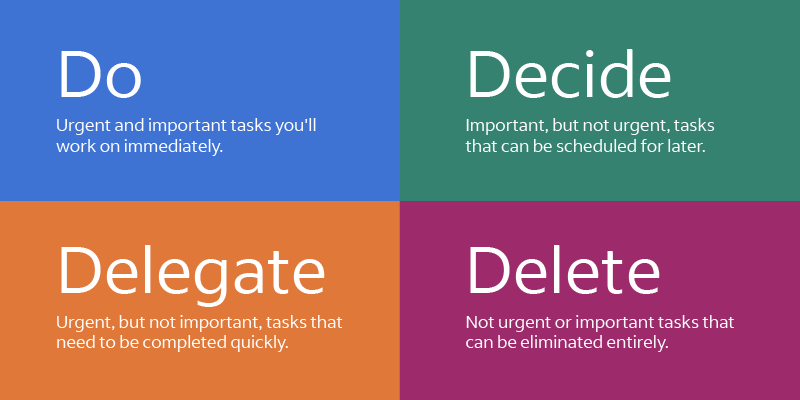If you’re like me (and I know you are!) tight deadlines are a constant source of stress in my professional life. On a basic level, I always seem to have too much to do and in too little time. And as much as I hope my to-do list magically turns into a done list, I know this won’t be changing anytime soon. It’s just the nature of marketing. If you’re not trying to put out a fire, you’re trying to light one under someone else in order to meet a deadline. The end result? We’re stressed, have a ton to do, but have no idea where to start.
But fear not! The Eisenhower Urgent/Important Decision Matrix is here to help.
This well-known and oft-cited productivity principle is purportedly what former U.S. President Dwight D. Eisenhower used to organize his workload. In a 1954 speech, Eisenhower said: “I have two kinds of problems: the urgent and the important. The urgent are not important, and the important are never urgent.”
At its core, Eisenhower’s Decision Matrix or Principle is a decision-making tool that helps you think through your priorities and escape the trap of missing what is truly important because you’re caught up in what is merely urgent.
In his famous book, The 7 Habits of Highly Effective People, Stephen Covey turns Eisenhower’s principle into a matrix that consists of a square divided into four quadrants labeled: 1) Urgent/Important, 2) Not Urgent/Important, 3) Urgent/Not Important, and 4) Not Urgent/Not Important.
Covey’s advice was to categorize all of your daily or weekly tasks (even/especially the small ones) into one of these quadrants in order to better understand the kinds of activities that are taking up your time. Here are the categories.

1. Urgent/Important
Tasks that require immediate attention and also work towards fulfilling our long-term professional and/or personal goals. This category is typically filled with crises that are out of our control and tasks that we’ve left to the last minute. Regardless of their source, these tasks put us in a reactive mindset that is fueled by cortisol and stress. Last-minute emergencies will never go away, but your goal isn’t to control the uncontrollable, it’s just to keep tasks out of this category by planning for and completing them before they become urgent. If you have a lot of things that fall into this category, identify which ones you could have foreseen and what you can do to prevent them (or activities like them) from becoming urgent in the future.
All of this is to say, to avoid becoming reactive choose to become proactive instead. How? Well, I’m glad you asked…
2. Important/Not Urgent
These are activities that may not have a pressing deadline, but help you achieve important professional or personal goals. Strengthening relationships, improving yourself, and long-term planning are the kinds of tasks that end up here. These are the proactive tasks that are critical for us in the long-term but often get ignored in the short-term. For me, these are the tasks I say I wish I had time for but rarely get to—it always seems something more urgent bumps them out of the way. Avoiding this pitfall is one of the major benefits of adopting this principle.
3. Urgent/Not Important
These tasks require your attention now but don’t have any long-term relevance to your bigger goals or mission. Think text messages, most emails, and helping your co-worker with their Zoom background. Category 3 tasks often involve helping others and this is where the people-pleaser in all of us gets us in trouble. While these tasks may be important to others, they’re not important to what you actually need to get done or what you want to be. If this category is overloaded, you probably need to say “no” more often and start delegating.
4. Not Urgent/Not Important
These tasks are exactly what you think they’d be. This is watching TV, doom scrolling on social media, and choosing what building to upgrade in Clash of Clans (speaking from experience here!). These are distractions, often enjoyable but never mission critical.
As an exercise, try creating this matrix on a piece of paper and categorizing your next week’s tasks accordingly. Just that activity alone will make you feel calmer, more composed, and more in control. But if you really want to make change (and become more productive and less stressed!), start investing the majority of your time in Category 2 tasks.
Why? Because by investing time in category 2’s planning and organizing activities, you can prevent many of the crises and problems that end up in category 1, balance the requests of category 3 with your own needs, and truly enjoy the mindless pleasures of category 4.
Once categorized, you can better schedule your tasks based on their actual importance. Doing so will allow you to better balance meeting urgent deadlines with planning for and accomplishing your long-term goals. As you can imagine, all of this leads to more productivity and less stress!
As marketers, it is every easy to fall into the trap of believing that all urgent activities are also important but this is never true. While some crises are unavoidable, the truth is, the more we can be proactive by attending to what is important, the less we have to be reactive while dealing with the urgent.










